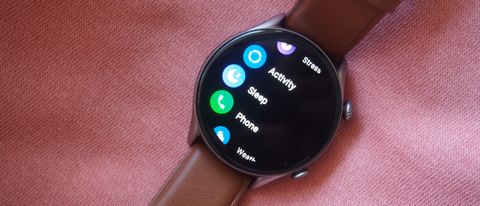TechRadar Verdict
The Amazfit GTR 3 Pro is a smartwatch that will look great on your wrist and offers up a nice mix of fitness and smartwatch staples for Android and iPhone owners. You’ll also get the kind of battery life that won’t have you charging it every day, but it’s still very early days with Zepp’s brand new OS and app store, which are lacking big name apps (and apps in general). Software isn’t free from the odd bug or two either, and ultimately the Pro is a good but not flawless smartwatch.
Pros
- +
Attractive, stylish watch design
- +
Packed with fitness features
- +
Easy to use
Cons
- -
App store not brimming with apps
- -
Sleep tracking is iffy
- -
Music player missing streaming service support
Why you can trust TechRadar
Two-minute review
The Amazfit GTR 3 Pro is a smartwatch that’s compatible with Android phones and iPhones, and creator Zepp has aimed to offer rich features wrapped up in a stylish design with a high quality display that costs less than the cheapest Apple Watch and Samsung Galaxy Watch. While it succeeds in making this a watch you’d want to wear, it still needs to refine things a little on the software front to truly rival those big hitters.
While Zepp’s new smartwatch operating system certainly looks and feels pretty slick, the barely stocked app store pales in comparison to storefronts you’ll find for the Apple Watch, WearOS and even Fitbit smartwatches.
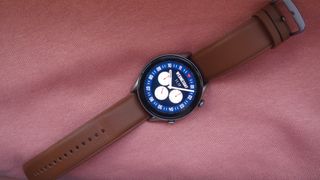
It does offer a nice array of smartwatch features, including easy to view notifications, a useful offline smart assistant, and Amazon Alexa. Music features are a mixed bag though, and playback controls are more useful than the built-in music player, which only works with your own purchased music.
Like previous Amazfit watches, the GTR 3 Pro goes big on fitness and sports tracking features and does better in some departments than others. Accuracy for things like GPS and heart rate are still best suited to more casual fitness folk. While 24/7 activity tracking is good on the whole, the sleep tracking and all-day heart rate monitoring can be buggy at times.
Battery life remains largely unchanged from the Amazfit GTR 2, giving you something that’s good for around a week depending on what features you regularly use. Ultimately, this isn’t a smartwatch you’ll be charging every day.
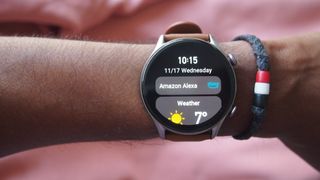
For the money, the GTR 3 Pro offers a lot. It’s a stylish connected timepiece that’s easy to use and it shows there are options outside of the high profile names to consider. You just have to accept that there might be some software niggles on the way and the new full-fat Zepp OS doesn’t quite match up to the competition in its current state.
Amazfit GTR 3 Pro Price and release date
The Amazfit GTR 3 Pro launched in October 2021 and is available directly from the Amazfit website and third-party retailers like Amazon for $229 / £179 (roughly AU$328). That's roughly the same price as the (at the time of writing) recently launched Fitbit Charge 5.
Design and display
- Waterproof up to 50 meters
- 22mm interchangeable straps
- AMOLED touchscreen display
The GTR 3 Pro features a 46mm case that measures in at 10.7mm thick, so that puts it bigger and thicker than something like the largest Samsung Galaxy Watch 4 for comparison.
That case is made from an aluminium alloy and that can be partnered up with a black infinite or brown leather look, which gives you the option of a more workout-friendly fluoroelastomer strap or a smarter leather one. As a package, you’re getting something that’s fit to be submerged in water up to 50 meters deep, but owners of the leather version may want to swap it out for something more suitable for going for a swim.
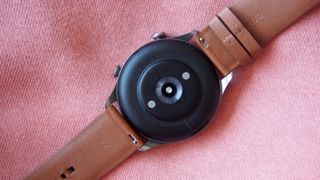
Both strap options are 22mm wide, with traditional watch-style buckles keeping them securely in place. You can remove them quite easily with the simple pin mechanism around the back. Our brown leather paired with silver case option was a pleasingly stylish look and it’s fair to say Zepp doesn’t have a problem making an attractive smartwatch.
That case holds in place a 1.45-inch, 480 x 480 resolution AMOLED touchscreen display, which is flanked by two physical buttons (the uppermost of which now resembles a watch crown. Zepp has already planted really impressive displays on the majority of its smartwatches and that doesn’t change here. It’s bright, colorful, and can be switched to always-on mode if you want that display on 24/7.
Around the back you’ll find an optical biometric sensor, which is capable of detecting heart rate and blood oxygen data. This is also the place you’ll have to drop on the magnetic charger, which is a little on the flimsy side easily knocked out of place.
Smartwatch features
- Zepp OS app store pretty bare
- Alexa and offline smart assistants
- Built-in music player
The headline news on the Pro is the introduction of Zepp OS, a new operating system that seeks to make improvements to the user interface, adding smoother animations and most crucially, adding an app store.
That store lies inside the Zepp companion phone app only, and seems to be largely made up of native apps that will let you do things like keep closer tabs on watch storage or add a flashlight. If you’re hoping for big name apps here like the ones you’ll find on the Apple App Store or the Google Play Store, that’s not happening. At a later date Zepp is planning to introduce a web-based developer kit to help ramp up the library of apps and watch faces, so maybe things will improve. Right now, it’s not brimming with options.
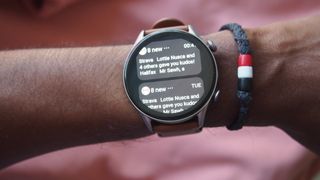
Outside of the improvements being added with Zepp OS, the Pro inherits a lot of what we saw on the GTR 2. You can view notifications from iPhone and Android phones, but again they aren't actionable.
You have both music controls and a built-in music player with 2.3GB of storage available, giving you room for anywhere from 270-470 songs. These can be MP3 and WAV audio files, and you’ll need to have those on your phone to add them to the watch.
You can still take calls when you’re paired to your phone over Bluetooth, which worked without issue for us, and there’s a healthy collection of watch faces (including ones optimized for when the always-on display mode is in play).
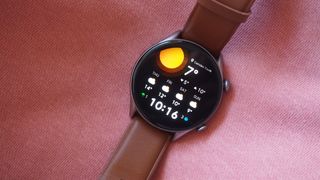
You still have two smart assistants in play here too, with Zepp’s own offering the ability to speak to your watch to ask it to control core features like playing music or checking in your fitness stats. When you’re online, you have Amazon’s Alexa assistant too, and both assistants on the whole performed well recognizing queries and commands.
Overall, it’s a competent smartwatch that doesn’t break new ground for what smartwatches are capable of, but you will find slicker performers in and around this price.
Fitness and sports tracking features
- Continuously track blood oxygen
- Measure four health metrics in 45-seconds
- New PeakBeats training insights
Zepp has sought to bolster the health and fitness tracking features on the GTR 3 Pro. Around the back you have an optical based BioTracker 3.0 sensor that’s capable of monitoring heart rate during exercise and continuously. It also means you can continuously track blood oxygen levels, and monitor stress through heart rate variability measurements. There’s even a temperature sensor packed in.
Sleep monitoring is covered too; the watch can capture a breakdown of your sleep stages including REM sleep and monitoring breathing quality, which was a feature in beta testing on the GTR 2.
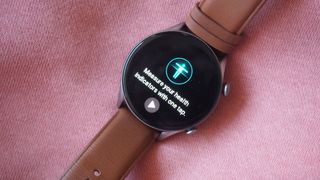
You’re getting Zepp’s PAI Health Assessment System, which generates a score based on you raising your heart rate through exercise on a regular basis. Zepp is now adding a new 45-second measurement as well, where you can see your heart rate, stress, blood oxygen, breathing rate to essentially give you a snapshot of your health. These aren’t for medical use though, and based on our testing we’d say that not all of those metrics in the snapshot are hugely accurate.
Switching to sports watch features, the GTR 3 Pro has pretty much everything you could want to track your exercise. There are 150+ sports modes, including everything from running to pool and open water swimming, indoor rowing, and elliptical training. There are even modes for a range of dances and combat sports.
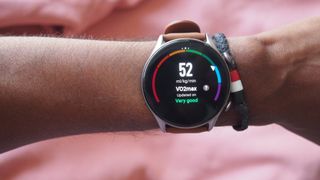
Eight of those activities are supported with automatic exercise recognition if you don’t want to start tracking workouts manually, including cycling, treadmill running and walking.
There’s support for the key five satellite navigation systems to make sure you get accurate outdoor exercise tracking and the new Peakbeats training insights are a clear riff on the FirstBeat heart rate based analytics included on Garmin’s watches, letting you see training effect, load and recovery time insights.
As a watch to turn to for fitness, health and sports tracking, we’d say the GTR 3 Pro does a good enough job for us. It definitely falls a little into the bracket of something like a Fitbit, though offers a little more in terms of metrics and insights over a Versa 3.
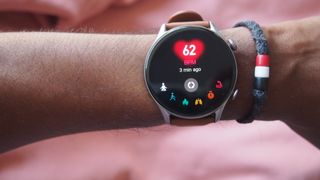
Step tracking, for instance, was generally in the ballpark against a rival fitness tracker though sleep tracking was patchy in terms of reliably delivering our sleep data each night. Zepp’s PAI Health Assessments still don’t feel all that useful or motivating, so it would be good to see Zepp build a bit more on this.
As mentioned, the promised health tracking is very much about offering guidance as opposed to giving you serious medical insights. We found that the heart rate monitor in general was largely accurate for real-time heart rate checks. It was a similar story with the blood oxygen readings when we compared it to a pulse oximeter. The temperature sensor however didn’t feel hugely reliable and was way off the readings from an actual thermometer.
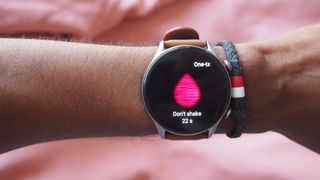
Sports tracking is good on the whole, and certainly works better for some exercises more than others in terms of delivering reliable data. Our outdoor runs came up a little short on distance tracking, though pool swims were nicely accurate. Indoor rowing sessions held up well too, though heart rate during exercise has its familiar issues.
It’s a case of another optical sensor that struggles to keep up with sudden spikes and drops in heart rate for high intensity training. That also means those new Peakbeats training insights that rely heavily on heart rate don’t seem like the most reliable.
Battery life
- Up to 12 days battery
- Takes two hours to charge from 0-100%
Battery performance on the GTR 3 Pro varies depending on how you use it and what you use, because some features will drain the battery more.
Zepp says you can expect up to 12 days' battery life based on a typical usage scenario. That jumps to 30 days if you switch to the battery saver mode. That battery saver mode turns off the Bluetooth connection and features like heart rate monitoring, leaving you with basics like steps and basic sleep data.
That drops to six days in heavy usage. If you’re using the GPS for tracking outdoor exercise, you can expect up to 35 hours battery life. To put that GPS battery life into perspective, Garmin’s similarly priced Forerunner 245 running watch offers up to 24 hours.
We’d say that the GTR 3 Pro is good for a week if you have features like notifications enabled, monitoring vitals continuously and using GPS for maybe two or three times a week. That’s similar performance to what the GTR 2 served up, so it’s good at least that things haven’t worryingly dropped off worryingly on the battery front.
First reviewed November 2021
Buy it if
You don’t want to spend big on a good-looking smartwatch
Zepp knows how to make an attractive smartwatch, and the GTR 3 Pro definitely has the materials, screen and sleek form factor to deliver that great look.
You love having a chat with your smartwatch
The Pro’s offline smart assistant works surprisingly well and with Amazon Alexa joining it too, you have good options to keep your hands away from that screen.
Don't buy it if
You want the best smartwatch experience
Zepp gets a lot right with the GTR 3 Pro, and while it’s improving as a smartwatch, you’ll get better elsewhere.
You love apps
Yes, Zepp does now have an app store, but right now this isn’t a storefront swimming with them or ones from big names either.
- On a budget? We've rounded up the best cheap fitness trackers
Michael is a freelance journalist who has covered consumer technology for over a decade and specializes in wearable and fitness tech. Previously editor of Wareable, he also co-ran the features and reviews sections of T3, and has a long list of bylines in the world of consumer tech sites.
With a focus on fitness trackers, headphones, running wearables, phones, and tablet, he has written for numerous publications including Wired UK, GQ, Men's Fitness, BBC Science Focus, Metro and Stuff, and has appeared on the BBC Travel Show. Michael is a keen swimmer, a runner with a number of marathons under his belt, and is also the co-founder of YouTube channel The Run Testers.
